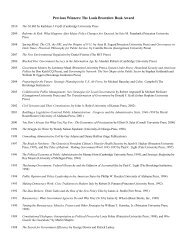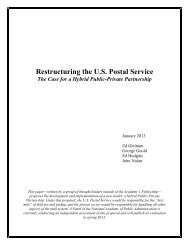High-Performance Partnerships - National Academy of Public ...
High-Performance Partnerships - National Academy of Public ...
High-Performance Partnerships - National Academy of Public ...
Create successful ePaper yourself
Turn your PDF publications into a flip-book with our unique Google optimized e-Paper software.
LEADERSHIP<br />
chapter five<br />
HOW TO MEET CHALLENGES<br />
TO LEADERSHIP<br />
Every high-performance partnership must be<br />
vigilant in addressing the challenges to establishing<br />
and maintaining effective leadership. The<br />
challenges deal with relationships and a partnership’s<br />
intangible features, not the actual bricks,<br />
mortar, or dollars. These aspects are difficult to<br />
quantify and resolve. Yet the lack <strong>of</strong> dynamic,<br />
strong leaders can doom a partnership faster<br />
than any other factor.<br />
STRONG LEADER VS. SHARED<br />
OWNERSHIP<br />
The Challenges<br />
One or several key decision-makers “convene”<br />
the parties during a partnership’s formative<br />
stage. Leadership <strong>of</strong>ten is centralized around a<br />
dynamic, inspirational individual or organization<br />
that can focus attention on the issues and<br />
create a collaborative environment. Centralized<br />
leadership may facilitate a cross-sector partnership,<br />
but a single leader cannot dominate collaborative<br />
endeavors indefinitely. A shared leadership<br />
structure is crucial for long-term viability.<br />
“A leader’s strength is defined by one’s ability to<br />
influence. Strong leaders must be able to balance<br />
their decisiveness with their ability to engage multiple<br />
partners.”<br />
Design Lab Participant<br />
The Medical Care for Children Partnership has<br />
existed for 15 years. Leadership is provided by an<br />
executive committee composed <strong>of</strong> representatives<br />
from every sector <strong>of</strong> the partnership. To address<br />
the leadership continuum, the executive committee<br />
has a co-chair, treasurer, and positions-elect, so that<br />
individuals have a learning experience before they<br />
actually begin their term. Officers who have<br />
completed their term remain in an ex-<strong>of</strong>ficio<br />
capacity. Over time, several individuals have recycled<br />
into the same position or assumed other leadership<br />
roles. Thus, all the partners share in the leadership<br />
and qualified others wait in the wings.<br />
The complexity and diversity among stakeholders<br />
and partners increase the imperative for a<br />
more decentralized leadership structure. An<br />
institution built around a single party is unlikely<br />
to weather transition well.<br />
Authority sharing is essential to a sustainable,<br />
effective partnership. Participants must feel a<br />
sense <strong>of</strong> shared ownership and be willing to<br />
accept joint accountability for results. Also, individual<br />
partners must reduce their parochial interests<br />
for the greater good. Yet attaining a collaborative<br />
decision-making approach can be difficult,<br />
especially with dynamic and directive leaders. As<br />
leadership functions are diffused throughout the<br />
partnership, sustaining broad commitment to the<br />
same vision and goals is challenging; partner<br />
organizations may have different cultures and<br />
approaches to problem solving.<br />
The Strategies<br />
1. Map assets to identify other leaders.<br />
During its initial start up, the partnership should<br />
map its assets and identify those that exhibit<br />
some or all <strong>of</strong> the Five Cs <strong>of</strong> Effective<br />
Leadership. It is important to nurture and train<br />
them and provide opportunities to develop their<br />
leadership skills. Mentoring opportunities, continuing<br />
education, and sometimes “trial by fire”<br />
are useful techniques.<br />
2. Invest in team building.<br />
Cross-sector partnerships <strong>of</strong>ten involve organizations<br />
that are unfamiliar to each other. Trust<br />
and real understanding may not exist at the outset.<br />
Investing in team building is investing in<br />
leadership development. This strategy assists<br />
participants in learning and understanding other<br />
philosophies and values, diffusing internal competition,<br />
and facilitating the power sharing needed<br />
for productive collaboration. A stronger<br />
team is more willing to share decision-making<br />
and accept accountability for results.<br />
3. Recruit from other successful initiatives.<br />
Qualities proven effective in other partnerships<br />
may be well suited for another endeavor. It is<br />
worthwhile to recruit parties with solid track<br />
records, convince them <strong>of</strong> a partnership’s value,<br />
and urge their participation as steering committee<br />
members, staff, or volunteers.<br />
78 Powering the Future: <strong>High</strong>-<strong>Performance</strong> <strong>Partnerships</strong>









